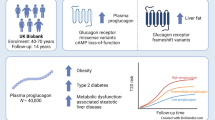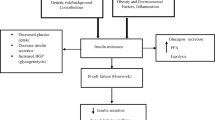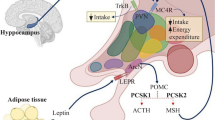Abstract
Melanocortin 4 receptor (MC4R) is an important regulator of food intake and number of studies report genetic variations influencing the risk of obesity. Here we explored the role of common genetic variation from MC4R locus comparing with SNPs from gene FTO locus, as well as the frequency and functionality of rare MC4R mutations in cohort of 380 severely obese individuals (BMI > 39 kg/m2) and 380 lean subjects from the Genome Database of Latvian Population (LGDB). We found correlation for two SNPs—rs11642015 and rs62048402 in the fat mass and obesity-associated protein (FTO) with obesity but no association was detected for rs17782313 located in the MC4R locus in these severely obese individuals. We sequenced the whole gene MC4R coding region in all study subjects and found five previously known heterozygous non-synonymous substitutions V103I, I121T, S127L, V166I and I251L. Expression in mammalian cells showed that the S127L, V166I and double V103I/S127L mutant receptors had significantly decreased quantity at the cell surface compared to the wild type MC4R. We carried out detailed functional analysis of V166I that demonstrated that, despite low abundance in plasma membrane, the V166I variant has lower EC50 value upon αMSH activation than the wild type receptor, while the level of AGRP inhibition was decreased, implying that V166I cause hyperactive satiety signalling. Overall, this study suggest that S127L may be the most frequent functional MC4R mutation leading to the severe obesity in general population and provides new insight into the functionality of population based variants of the MC4R.

Similar content being viewed by others
References
Cone RD (2005) Anatomy and regulation of the central melanocortin system. Nat Neurosci 8(5):571–578. doi:10.1038/nn1455
Mountjoy KG, Mortrud MT, Low MJ, Simerly RB, Cone RD (1994) Localization of the melanocortin-4 receptor (MC4-R) in neuroendocrine and autonomic control circuits in the brain. Mol Endocrinol 8(10):1298–1308
Huszar D, Lynch CA, Fairchild-Huntress V, Dunmore JH, Fang Q, Berkemeier LR, Gu W, Kesterson RA, Boston BA, Cone RD, Smith FJ, Campfield LA, Burn P, Lee F (1997) Targeted disruption of the melanocortin-4 receptor results in obesity in mice. Cell 88(1):131–141
Kask A, Mutulis F, Muceniece R, Pahkla R, Mutule I, Wikberg JE, Rago L, Schioth HB (1998) Discovery of a novel superpotent and selective melanocortin-4 receptor antagonist (HS024): evaluation in vitro and in vivo. Endocrinology 139(12):5006–5014
Biebermann H, Krude H, Elsner A, Chubanov V, Gudermann T, Gruters A (2003) Autosomal-dominant mode of inheritance of a melanocortin-4 receptor mutation in a patient with severe early-onset obesity is due to a dominant-negative effect caused by receptor dimerization. Diabetes 52(12):2984–2988
Hinney A, Bettecken T, Tarnow P, Brumm H, Reichwald K, Lichtner P, Scherag A, Nguyen TT, Schlumberger P, Rief W, Vollmert C, Illig T, Wichmann HE, Schafer H, Platzer M, Biebermann H, Meitinger T, Hebebrand J (2006) Prevalence, spectrum, and functional characterization of melanocortin-4 receptor gene mutations in a representative population-based sample and obese adults from Germany. J Clin Endocrinol Metab 91(5):1761–1769. doi:10.1210/jc.2005-2056
Tao YX (2010) The melanocortin-4 receptor: physiology, pharmacology, and pathophysiology. Endocr Rev 31(4):506–543. doi:10.1210/er.2009-0037
Calton MA, Ersoy BA, Zhang S, Kane JP, Malloy MJ, Pullinger CR, Bromberg Y, Pennacchio LA, Dent R, McPherson R, Ahituv N, Vaisse C (2009) Association of functionally significant Melanocortin-4 but not Melanocortin-3 receptor mutations with severe adult obesity in a large North American case-control study. Hum Mol Genet 18(6):1140–1147. doi:10.1093/hmg/ddn431
Fan ZC, Tao YX (2009) Functional characterization and pharmacological rescue of melanocortin-4 receptor mutations identified from obese patients. J Cell Mol Med 13(9B):3268–3282. doi:10.1111/j.1582-4934.2009.00726.x
Hinney A, Hohmann S, Geller F, Vogel C, Hess C, Wermter AK, Brokamp B, Goldschmidt H, Siegfried W, Remschmidt H, Schafer H, Gudermann T, Hebebrand J (2003) Melanocortin-4 receptor gene: case-control study and transmission disequilibrium test confirm that functionally relevant mutations are compatible with a major gene effect for extreme obesity. J Clin Endocrinol Metab 88(9):4258–4267
Lubrano-Berthelier C, Durand E, Dubern B, Shapiro A, Dazin P, Weill J, Ferron C, Froguel P, Vaisse C (2003) Intracellular retention is a common characteristic of childhood obesity-associated MC4R mutations. Hum Mol Genet 12(2):145–153
Valli-Jaakola K, Lipsanen-Nyman M, Oksanen L, Hollenberg AN, Kontula K, Bjorbaek C, Schalin-Jantti C (2004) Identification and characterization of melanocortin-4 receptor gene mutations in morbidly obese finnish children and adults. J Clin Endocrinol Metab 89(2):940–945
Xiang Z, Litherland SA, Sorensen NB, Proneth B, Wood MS, Shaw AM, Millard WJ, Haskell-Luevano C (2006) Pharmacological characterization of 40 human melanocortin-4 receptor polymorphisms with the endogenous proopiomelanocortin-derived agonists and the agouti-related protein (AGRP) antagonist. Biochemistry 45(23):7277–7288. doi:10.1021/bi0600300
Staubert C, Tarnow P, Brumm H, Pitra C, Gudermann T, Gruters A, Schoneberg T, Biebermann H, Rompler H (2007) Evolutionary aspects in evaluating mutations in the melanocortin 4 receptor. Endocrinology 148(10):4642–4648. doi:10.1210/en.2007-0138
Mirshahi UL, Still CD, Masker KK, Gerhard GS, Carey DJ, Mirshahi T (2011) The MC4R(I251L) allele is associated with better metabolic status and more weight loss after gastric bypass surgery. J Clin Endocrinol Metab 96(12):E2088–2096. doi:10.1210/jc.2011-1549
Stutzmann F, Vatin V, Cauchi S, Morandi A, Jouret B, Landt O, Tounian P, Levy-Marchal C, Buzzetti R, Pinelli L, Balkau B, Horber F, Bougneres P, Froguel P, Meyre D (2007) Non-synonymous polymorphisms in melanocortin-4 receptor protect against obesity: the two facets of a Janus obesity gene. Hum Mol Genet 16(15):1837–1844. doi:10.1093/hmg/ddm132
Wang D, Ma J, Zhang S, Hinney A, Hebebrand J, Wang Y, Wang HJ (2010) Association of the MC4R V103I polymorphism with obesity: a Chinese case-control study and meta-analysis in 55,195 individuals. Obesity (Silver Spring) 18(3):573–579. doi:10.1038/oby.2009.268
Young EH, Wareham NJ, Farooqi S, Hinney A, Hebebrand J, Scherag A, O’Rahilly S, Barroso I, Sandhu MS (2007) The V103I polymorphism of the MC4R gene and obesity: population based studies and meta-analysis of 29 563 individuals. Int J Obes (Lond) 31(9):1437–1441. doi:10.1038/sj.ijo.0803609
Stokic E, Djan M, Vapa L, Djan I, Plecas A, Srdic B (2010) Polymorphism Val103Ile of the melanocortin-4 receptor gene in the Serbian population. Mol Biol Rep 37(1):33–37. doi:10.1007/s11033-009-9500-z
Consortium WTCC (2007) Genome-wide association study of 14,000 cases of seven common diseases and 3,000 shared controls. Nature 447(7145):661–678. doi:10.1038/nature05911
Loos RJ, Lindgren CM, Li S, Wheeler E, Zhao JH, Prokopenko I, Inouye M, Freathy RM, Attwood AP, Beckmann JS, Berndt SI, Jacobs KB, Chanock SJ, Hayes RB, Bergmann S, Bennett AJ, Bingham SA, Bochud M, Brown M, Cauchi S, Connell JM, Cooper C, Smith GD, Day I, Dina C, De S, Dermitzakis ET, Doney AS, Elliott KS, Elliott P, Evans DM, Sadaf Farooqi I, Froguel P, Ghori J, Groves CJ, Gwilliam R, Hadley D, Hall AS, Hattersley AT, Hebebrand J, Heid IM, Lamina C, Gieger C, Illig T, Meitinger T, Wichmann HE, Herrera B, Hinney A, Hunt SE, Jarvelin MR, Johnson T, Jolley JD, Karpe F, Keniry A, Khaw KT, Luben RN, Mangino M, Marchini J, McArdle WL, McGinnis R, Meyre D, Munroe PB, Morris AD, Ness AR, Neville MJ, Nica AC, Ong KK, O’Rahilly S, Owen KR, Palmer CN, Papadakis K, Potter S, Pouta A, Qi L, Randall JC, Rayner NW, Ring SM, Sandhu MS, Scherag A, Sims MA, Song K, Soranzo N, Speliotes EK, Syddall HE, Teichmann SA, Timpson NJ, Tobias JH, Uda M, Vogel CI, Wallace C, Waterworth DM, Weedon MN, Willer CJ, Wraight, Yuan X, Zeggini E, Hirschhorn JN, Strachan DP, Ouwehand WH, Caulfield MJ, Samani NJ, Frayling TM, Vollenweider P, Waeber G, Mooser V, Deloukas P, McCarthy MI, Wareham NJ, Barroso I, Kraft P, Hankinson SE, Hunter DJ, Hu FB, Lyon HN, Voight BF, Ridderstrale M, Groop L, Scheet P, Sanna S, Abecasis GR, Albai G, Nagaraja R, Schlessinger D, Jackson AU, Tuomilehto J, Collins FS, Boehnke M, Mohlke KL (2008) Common variants near MC4R are associated with fat mass, weight and risk of obesity. Nat Genet 40(6):768–775. doi:10.1038/ng.140
Hardy R, Wills AK, Wong A, Elks CE, Wareham NJ, Loos RJ, Kuh D, Ong KK (2010) Life course variations in the associations between FTO and MC4R gene variants and body size. Hum Mol Genet 19(3):545–552. doi:10.1093/hmg/ddp504
Haupt A, Thamer C, Heni M, Tschritter O, Machann J, Schick F, Machicao F, Haring HU, Staiger H, Fritsche A (2009) Impact of variation near MC4R on whole-body fat distribution, liver fat, and weight loss. Obesity (Silver Spring) 17(10):1942–1945. doi:10.1038/oby.2009.233
Timpson NJ, Harbord R, Davey Smith G, Zacho J, Tybjaerg-Hansen A, Nordestgaard BG (2009) Does greater adiposity increase blood pressure and hypertension risk?: mendelian randomization using the FTO/MC4R genotype. Hypertension 54(1):84–90. doi:10.1161/HYPERTENSIONAHA.109.130005
Zobel DP, Andreasen CH, Grarup N, Eiberg H, Sorensen TI, Sandbaek A, Lauritzen T, Borch-Johnsen K, Jorgensen T, Pedersen O, Hansen T (2009) Variants near MC4R are associated with obesity and influence obesity-related quantitative traits in a population of middle-aged people: studies of 14,940 Danes. Diabetes 58(3):757–764. doi:10.2337/db08-0620
Frayling TM, Timpson NJ, Weedon MN, Zeggini E, Freathy RM, Lindgren CM, Perry JR, Elliott KS, Lango H, Rayner NW, Shields B, Harries LW, Barrett JC, Ellard S, Groves CJ, Knight B, Patch AM, Ness AR, Ebrahim S, Lawlor DA, Ring SM, Ben-Shlomo Y, Jarvelin MR, Sovio U, Bennett AJ, Melzer D, Ferrucci L, Loos RJ, Barroso I, Wareham NJ, Karpe F, Owen KR, Cardon LR, Walker M, Hitman GA, Palmer CN, Doney AS, Morris AD, Smith GD, Hattersley AT, McCarthy MI (2007) A common variant in the FTO gene is associated with body mass index and predisposes to childhood and adult obesity. Science 316(5826):889–894. doi:10.1126/science.1141634
Wang H, Dong S, Xu H, Qian J, Yang J (2012) Genetic variants in FTO associated with metabolic syndrome: a meta- and gene-based analysis. Mol Biol Rep 39(5):5691–5698. doi:10.1007/s11033-011-1377-y
Xi B, Zhang M, Wang C, Shen Y, Zhao X, Wang X, Mi J (2013) The common SNP (rs9939609) in the FTO gene modifies the association between obesity and high blood pressure in Chinese children. Mol Biol Rep. doi:10.1007/s11033-012-2113-y
Zhou D, Liu H, Zhou M, Wang S, Zhang J, Liao L, He F (2012) Common variant (rs9939609) in the FTO gene is associated with metabolic syndrome. Mol Biol Rep 39(6):6555–6561. doi:10.1007/s11033-012-1484-4
Little J, Higgins JP, Ioannidis JP, Moher D, Gagnon F, von Elm E, Khoury MJ, Cohen B, Davey-Smith G, Grimshaw J, Scheet P, Gwinn M, Williamson RE, Zou GY, Hutchings K, Johnson CY, Tait V, Wiens M, Golding J, van Duijn C, McLaughlin J, Paterson A, Wells G, Fortier I, Freedman M, Zecevic M, King R, Infante-Rivard C, Stewart AF, Birkett N (2009) Strengthening the reporting of genetic association studies (STREGA): an extension of the strengthening the reporting of observational studies in epidemiology (STROBE) statement. J Clin Epidemiol 62(6):597–608 e594. doi:10.1016/j.jclinepi.2008.12.004
Ignatovica V, Latkovskis G, Peculis R, Megnis K, Schioth HB, Vaivade I, Fridmanis D, Pirags V, Erglis A, Klovins J (2011) Single nucleotide polymorphisms of the purinergic 1 receptor are not associated with myocardial infarction in a Latvian population. Mol Biol Rep 39(2):1917–25. doi:10.1007/s11033-011-0938-4
Peculis R, Latkovskis G, Tarasova L, Pirags V, Erglis A, Klovins J (2011) A nonsynonymous variant I248L of the adenosine A3 receptor is associated with coronary heart disease in a Latvian population. DNA Cell Biol 30(11):907–911. doi:10.1089/dna.2011.1230
Purcell S, Neale B, Todd-Brown K, Thomas L, Ferreira MA, Bender D, Maller J, Sklar P, de Bakker PI, Daly MJ, Sham PC (2007) PLINK: a tool set for whole-genome association and population-based linkage analyses. Am J Hum Genet 81(3):559–575. doi:10.1086/519795
Gauderman WJ, Morrison JM (2006) QUANTO 1.1: a computer program for power and sample size calculations for genetic-epidemiology studies. http://hydra.usc.edu/gxe
Sallman Almen M, Rask-Andersen M, Jacobsson JA, Ameur A, Kalnina I, Moschonis G, Juhlin S, Bringeland N, Hedberg LA, Ignatovica V, Chrousos GP, Manios Y, Klovins J, Marcus C, Gyllensten U, Fredriksson R, Schioth HB (2012) Determination of the obesity-associated gene variants within the entire FTO gene by ultra-deep targeted sequencing in obese and lean children. Int J Obes (Lond) 37(3):424–31. doi:10.1038/ijo.2012.57
Fridmanis D, Petrovska R, Kalnina I, Slaidina M, Peculis R, Schioth HB, Klovins J (2010) Identification of domains responsible for specific membrane transport and ligand specificity of the ACTH receptor (MC2R). Mol Cell Endocrinol 321(2):175–183. doi:10.1016/j.mce.2010.02.032
Ignatovica V, Megnis K, Lapins M, Schioth HB, Klovins J (2012) Identification and analysis of functionally important amino acids in human purinergic 12 receptor using a Saccharomyces cerevisiae expression system. FEBS J 279(1):180–191. doi:10.1111/j.1742-4658.2011.08410.x
Webb TR, Chan L, Cooray SN, Cheetham ME, Chapple JP, Clark AJ (2009) Distinct melanocortin 2 receptor accessory protein domains are required for melanocortin 2 receptor interaction and promotion of receptor trafficking. Endocrinology 150(2):720–726. doi:10.1210/en.2008-0941
Been LF, Nath SK, Ralhan SK, Wander GS, Mehra NK, Singh J, Mulvihill JJ, Sanghera DK (2009) Replication of association between a common variant near melanocortin-4 receptor gene and obesity-related traits in Asian Sikhs. Obesity (Silver Spring) 18(2):425–429. doi:10.1038/oby.2009.254
Chambers JC, Elliott P, Zabaneh D, Zhang W, Li Y, Froguel P, Balding D, Scott J, Kooner JS (2008) Common genetic variation near MC4R is associated with waist circumference and insulin resistance. Nat Genet 40(6):716–718. doi:10.1038/ng.156
Wang CL, Liang L, Wang HJ, Fu JF, Hebebrand J, Hinney A (2006) Several mutations in the melanocortin 4 receptor gene are associated with obesity in Chinese children and adolescents. J Endocrinol Investig 29(10):894–898
Lubrano-Berthelier C, Dubern B, Lacorte JM, Picard F, Shapiro A, Zhang S, Bertrais S, Hercberg S, Basdevant A, Clement K, Vaisse C (2006) Melanocortin 4 receptor mutations in a large cohort of severely obese adults: prevalence, functional classification, genotype-phenotype relationship, and lack of association with binge eating. J Clin Endocrinol Metab 91(5):1811–1818. doi:10.1210/jc.2005-1411
Grieco P, Brancaccio D, Novellino E, Hruby VJ, Carotenuto A (2011) Conformational study on cyclic melanocortin ligands and new insight into their binding mode at the MC4 receptor. Eur J Med Chem 46(9):3721–3733. doi:10.1016/j.ejmech.2011.05.038
Kalnina I, Kapa I, Pirags V, Ignatovica V, Schioth HB, Klovins J (2009) Association between a rare SNP in the second intron of human Agouti related protein gene and increased BMI. BMC Med Genet 10:63. doi:10.1186/1471-2350-10-63
Muhlhaus J, Putter C, Brumm H, Grallert H, Illig T, Scherag S, Reinehr T, Pott W, Albayrak O, Wang HJ, Bau AM, Wiegand S, Gruters A, Krude H, Hebebrand J, Hinney A, Biebermann H, Scherag A (2012) Do common variants separate between obese melanocortin-4 receptor gene mutation carriers and non-carriers? The impact of cryptic relatedness. Horm Res Paediatr 77(6):358–368. doi:10.1159/000338999
Acknowledgments
This work was supported by ERDF Project No. 2010/0311/2DP/2.1.1.1.0/10/APIA/VIAA/069 and the Latvian Research Program (4VPP-2010-2/2.1). HBS was supported by the Swedish Research Council. We acknowledge the Genome Database of Latvian population, Latvian Biomedical Research and the Study Centre for providing data and DNA samples.
Author information
Authors and Affiliations
Corresponding author
Electronic supplementary material
Below is the link to the electronic supplementary material.
Rights and permissions
About this article
Cite this article
Rovite, V., Petrovska, R., Vaivade, I. et al. The role of common and rare MC4R variants and FTO polymorphisms in extreme form of obesity. Mol Biol Rep 41, 1491–1500 (2014). https://doi.org/10.1007/s11033-013-2994-4
Received:
Accepted:
Published:
Issue Date:
DOI: https://doi.org/10.1007/s11033-013-2994-4




